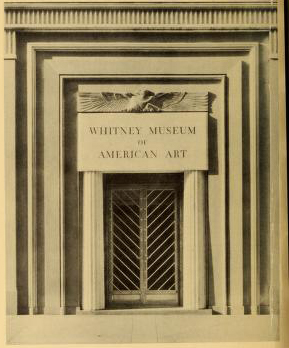New York City is full of excitement over the opening of the Whitney Museum of American Art in its new Chelsea space. Designed by the famed Renzo Piano, the new building is significantly larger than its previous home on the Upper East Side. While this is not the first time the Whitney has moved, a lot has changed. When the previous incarnation was built in 1966 by Marcel Breuer the collection contained only around 2,000 artworks, now there are more than 19,000. With 50,000 sq ft of indoor exhibition space and 13,000 sq ft of outdoor space/terraces and a Danny Meyer restaurant, the Whitney has seriously upgraded. And no wonder, with a project budget of $720 million.
The Whitney Museum 1937 to the Present
During a sneak preview, OTE appraiser Alanna Butera, was definitely impressed. The excitement of the crowd during the preview spoke to the overall enthusiasm about the Whitney’s reopening. The new space couldn’t be more different than its former building on Madison Ave., something our appraiser noticed immediately. Alanna noted that part its charm is the light in the space, many windows and outdoor areas, and if you are there in the evening you will probably be lucky enough to witness a beautiful sunset.
Overall it seems as if the new building is well received. Paul Goldberger, architectural critic, and contributing editor for Vanity Fair wrote that, “the galleries offer the best balance I’ve ever seen between the primary mission of allowing you to focus on the art and the secondary purpose of engaging with the city.”
This is exactly what Renzo Piano intended. To Piano (via the Whitney’s website), the brilliance of the new Whitney is that “here all at once, you have the water, the park, the powerful industrial structures and the exciting mix of people, brought together and focused by this new building and the experience of art.” So I guess we’ll call it a success.
The inaugural exhibition "America Is Hard to See," a title recycled from a 1951 Robert Frost poem, has incurred a bit more dissent. Although our appraiser enjoyed the new show (which will officially open May 1st) it has not been as popular with all critics. A review in the LA Times by Christopher Knight, stuck out in particular. The title “At new Whitney Museum site, a show is shrouded in parochialism” pretty much tells you exactly what Knight thinks. As reported by Knight, the new show, which features more than 400 artists and almost 650 artworks from 1900 to the present, has a long way to go from being curatorially Manhattan-centric.
However, the buzz surrounding the exhibition is mostly good. A review in the New York Times by Holland Cotter (Review: New Whitney Museum’s First Show, ‘America Is Hard to See') was much more positive. It appears that thanks to the new space the Whitney is able to pull off an exhibition of a more ambitious scale and scope. Something OTE's preview hopping appraiser agrees with. Despite some Manhattan favoritism, she thought the overall show spoke to consistent American art themes and styles throughout the period.
One thing no one can deny, this is an exciting new chapter for the Whitney Museum of American Art.








